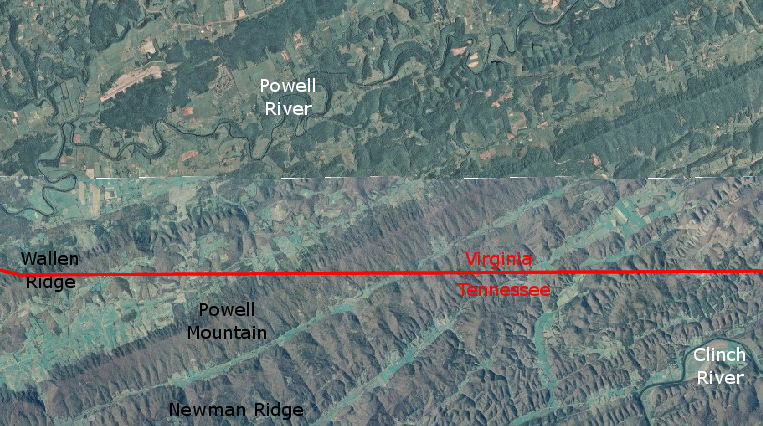
the Melungeons community is concentrated in the Valley and Ridge province of southwestern Virginia and northeastern Tennessee
Source: US Geological Survey National Map

the Melungeons community is concentrated in the Valley and Ridge province of southwestern Virginia and northeastern Tennessee
Source: US Geological Survey National Map
The Melungeons are an ethnic group in southwestern Virginia, concentrated in the Powell River and Clinch River watersheds of Lee, Scott, and Wise counties. The center of the Melungeon community is around Newman's Ridge in Tennessee, near Sneedville in Hawkins County.
The Melungeons are a mixed-race group which has claimed to be descended from Portuguese and Turkish ancestors. Across Central and South America, there are multiple "mestizo" cultures that developed from the offspring of predominantly European men and Native/African women. The Melungeons claimed descent from Europeans and Native Americans, while minimizing the potential of Africans being in the family tree as well.
The claim to be descended from European and Native America parents was an effective story developed in the early 1800's to minimize increasing racial discrimination against those with African ancestors. Dark skin and swarthy features could be cited as characteristic features of Portuguese and Turkish genes, so Melungeons would not be classified as "Negro."
Overcoming discrimination based on skin color was a major challenge. Fear of slave revolts and increasing racial bias among whites after 1800 led to new limits on social and economic opportunity for anyone with African heritage. A claim to being "Portuguese" could create sufficient ambiguity for people to be classified as white, so long as a neighbor did not contest the claim in court in order to gain some advantage. For example, some people classified as "free people of color" in the 1830 Census in northeastern Tennessee were categorized as "white" in the 1840 Census.
The mestizo societies evolved in Spanish and Portuguese colonies in the 1500's and 1600's because few women from those countries emigrated to the New World. Nearly all European men who wanted female companionship in the Western Hemisphere were left with choosing African or Native American women as partners.
However, Melungeon ancestry may be the opposite. As described in a 2021 report published in Journal of Genetic Genealogy:1
Mixed-race families formed initially on the boundaries of English settlement, as white indentured servants brought from England and blacks imported involuntarily from Africa had children together. Mixed-race families faced racial discrimination in Virginia as "black" became associated with "enslaved" during the 1600's, and a legal system evolved to maintain chattel slavery. Children born to a white mother were technically free, but anyone with a dark skin color risked being accused of being an escaped slave.
Colorism, or discrimination based on skin tone, has been common across the United States for 400 years. In urban African-American communities, the grocery bag test has been applied in some quarters. People with a skin color lighter than a brown paper grocery bag have been judged as "good" or "not black enough."
Mixed-race communities developed in all the southern colonies. The Lumbee in North Carolina is a state-recognized tribe, but the ancestors include various Algonquian groups as well as whites and enslaved workers. The "brass ankles" or "redbones" of South Carolina also have a mixed heritage.
In southeastern Virginia, maroon communities survived in the Dismal Swamp on lands that white settlers did not desire to farm. As the English population grew in the Piedmont, mixed-race families had to migrate west to stay in the borderlands and avoid being surrounded by white farmers.
The people who ended up being labeled "Melungeons" moved west from early Hanover County and Louisa County in the 1720's, ultimately crossing the Blue Ridge into the New River Valley of Tennessee and Virginia. As more settlers moved south along the Wilderness Road, the Melungeons moved further south. As English settlers crossed the Blue Ridge to occupy Tennessee after the American Revolution, the Melungeons were squeezed out of the fertile valley bottomlands with limestone soils. They moved uphill to lands not desired by the white farmers, clearing patches of forest on mountain ridges with less-productive farmland on top of sandstone and shale bedrock.
By the early 1800's, there were around 40 families living near the Virginia-Tennessee border who had physical features that distinguished them from the settlers with English, Scottish, Irish, and German ancestors.2
An 1848 article reprinted in the Knoxville Register reported on the distinctive Melungeon population living in a narrow gorge between Powell's Mountain and the Copper Ridge:3
As described in 1912:4
Source: Virginia Public Media, What it means to identify as Melungeon
The origin of the Melungeons has been the focus of various hypotheses. Many articles in the popular (as opposed to academic) literature highlight the exotic potential of European ancestry, because that would evade the restrictions of Jim Crow laws which limited the ability win court cases to retain land and property:
- Some of the men from Hernando de Soto's 1540 expedition, or Juan Pardo's explorations of western North Carolina in 1566-67, fathered children with the local Native Americans and triggered a new genetic subgroup.
- During his 1586 raid on Cartagena, Sir Francis Drake captured hundreds of men and women that the Spanish had enslaved. Drake stopped on Roanoke Island on the way home, and chose to leave the "Turks" from Cartegena to make room for evacuating the failing English colony (a year before the "Lost Colony" arrived in 1587). The "Turks" migrated inland from Albemarle Sound over the next 400 years, perhaps intermarrying with Native Americans but retaining their distinctive physical and cultural patterns
- North African Moors (people with light skin living north of the Sahara Desert) sailed to the eastern edge of North America on their own initiative, then moved to the Clinch River valley near Cumberland Gap while maintaining enough cultural and genetic cohesion to start the Melungeon community
The extent of Native American heritage is not clear in modern DNA studies. In contrast to Mexico and other places settled by Spanish and Portuguese colonists in the 1500's, English colonists did not intermarry legally with Native Americans.
Virginia did not develop a mestizo society where mixed-race heritage was common. In 1662, the General Assembly banned sexual relations between Christians and any Negro man or woman. Starting in 1691, the Virginia legislature began to define "white." Any marriage between English and negroes, mulattoes, or Indians would lead to permanent banishment between the colony, and any child born by an unmarried English woman to a negro or mulatto would be bound out as a servant until the age of 30. In the opinion of the white men in the General Assembly, the measures were needed:5
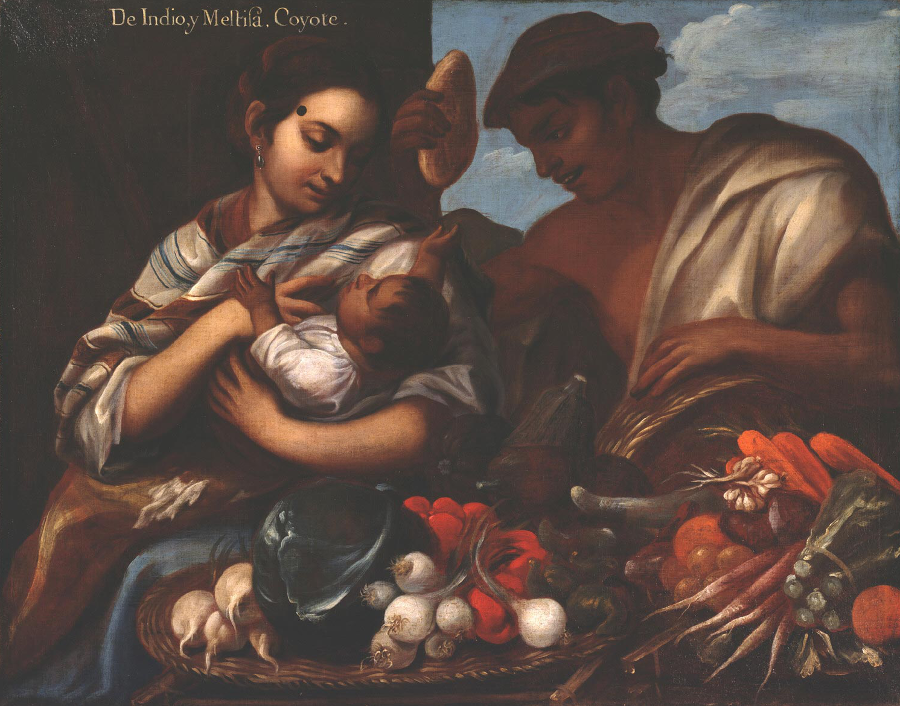
in the 1500's, children of Spanish colonists/Native Americans were labeled "mestizo," and children of mestizo/Native Americans were labeled "coyotes"
Source: Philadelphia Museum of Art, From Indian and Mestiza, Coyote (painting attributed to Jose de Alcebar)
Nonetheless, the conclusion of anthropologists and geneticists is that Melungeons are the not descendants of "Turks" or Moors who managed to maintain their distinct physical characteristics while migrating through Native American towns to the Appalachians. Modern Melungeons are a mixed-race community with genes from whites, blacks, and Native Americans. One technical term for such genetic mixing is to describe the resulting population as "tri-racial isolates." Describing mixed-race persons in North America as "mulatto" has been associated with social discrimination and legal constraints under Jim Crow laws, and can trigger emotional responses when used today.
Prior to the Civil War, Melungeons faced social discrimination because of their appearance. Emphasizing Cherokee blood lines or the exotic potential of Portuguese ancestors provided a different explanation other than African heritage for physical characteristics.
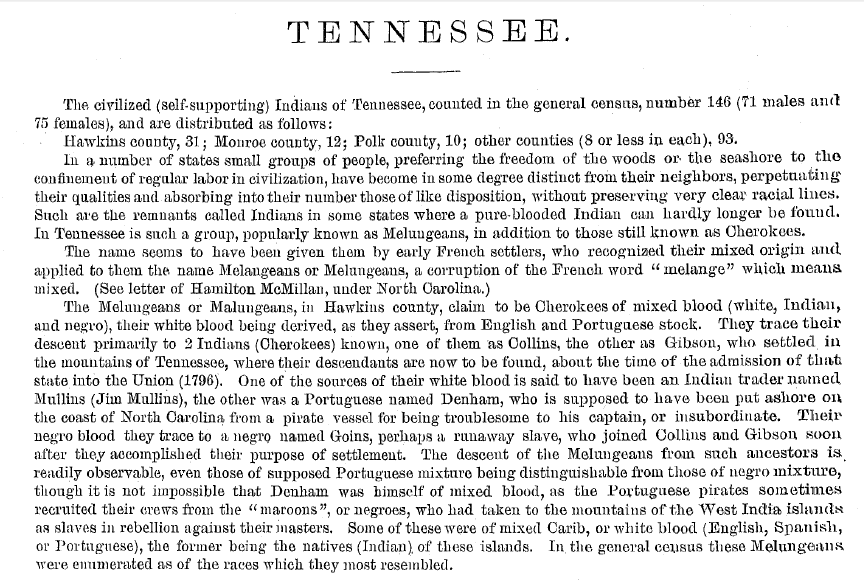
1890 Census report on Melungeons in Tennessee
Source: Bureau of Census, 1890 Census, Volume 10: Report on Indians Taxed and Indians Not Taxed in the United States (except Alaska)
After the Civil War ended formal slavery, Virginia passed laws to discriminate against people of color and segregate white society from "others." Virginia considered classifying all people with one drop of non-white blood as "colored," then made an exception for the descendants of Pocahontas. Most infamously, the 1924 Racial Integrity Act stated:6
Various Jim Crow state laws required discrimination, blocking equal access to government services such as public schools and seating choices on local buses. Custom, tradition, and often the bylaws/articles of incorporation blocked equal access for people of color to private organizations, businesses, and public services. Water fountains and lunch counters were segregated, so many of the Melungeon chose to isolate themselves rather than accept discrimination.
Melungeons found it wise to claim Native American or non-African heritage. An article by an attorney living at Newman's Ridge in Tennessee claimed in 1915 that the physical expression of the Native American heritage was no longer obvious:7
In 1874 a lawyer drew on Melungeon lore when he argued that his client was white, and thus entitled to inherit the estate of her father:8
The lawyer also noted that the discrimination was based less on skin color and more on association with Africa:9
By 1950, there were about 15,000 people who were described as "Melungeons."10
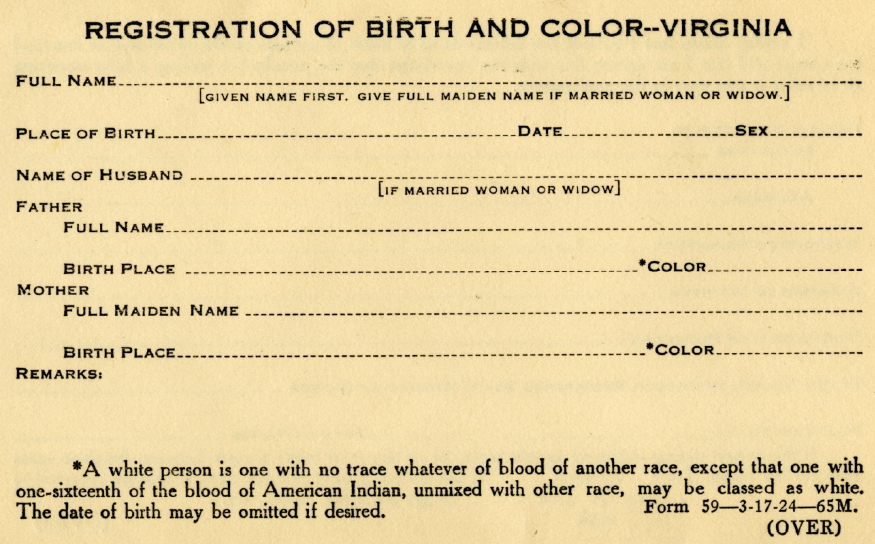
the Virginia Bureau of Vital Statistics implemented the 1924 Racial Integrity Act, requiring individuals to be according to the state's definition of race
Source: Library of Virginia, Registration of Birth and Color, 1924
Into the 1960's, Virginia's government agencies, private businesses, and social organizations legally discriminated on the basis of race. Even after the US Congress passed new civil rights legislation and Federal court decisions after World War II limited the legal authority to discriminate, the incentive to be classified as Portuguese, Turk, North African Berber, etc. rather than "colored" was still clear.
In the 1990's, those who had been labeled as Melungeon and experienced discrimination chose to acknowledge and research their heritage. Rejecting the label "Melungeon" as a slur. and embracing it instead. led to Melungeon Family Reunions:11
In 1997, Brent Kennedy published The Melungeons: The Resurrection of a Proud People - An Untold Story of Ethnic Cleansing in America. Initially, it drew a strong reaction from historians and genealogists who noted the absence of evidence to document the key claim:12
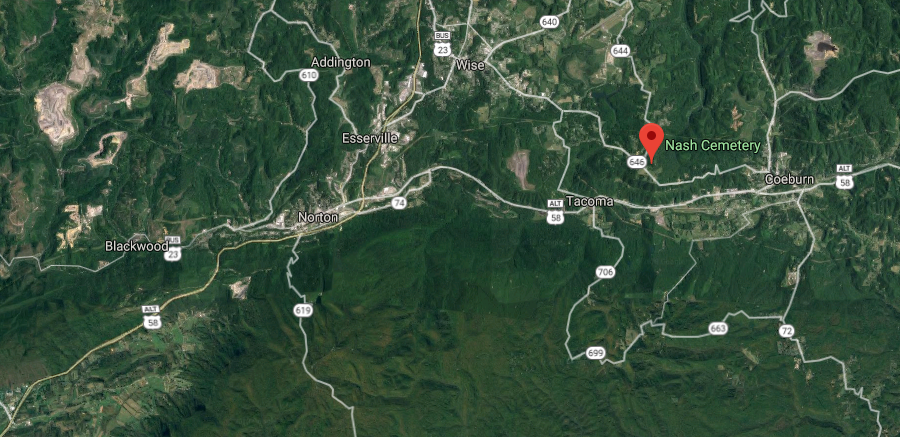
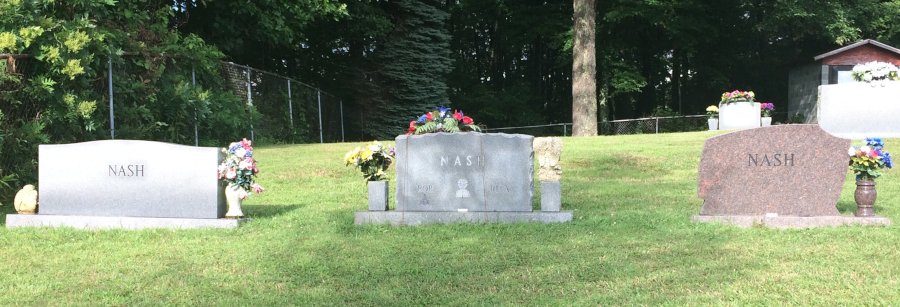
the Nash Cemetery between Wise and Coeburn is the last resting place for many Melungeon families
Source: GoogleMaps
Since then, genetics has been able to separate some facts from fiction. Mixed-race heritage has been revealed by DNA analysis of relatives in 69 male lines and 8 female lines which can be raced back without a break to the early 1800's. Discrimination had forced families to intermarry within each other, facilitating the research.
Jack Goins triggered the research into his Melungeon heritage, and was surprised by how the results contradicted his previous understanding. He had relatives who had been listed as Portuguese on an 1880 census, but after testing his own DNA 13